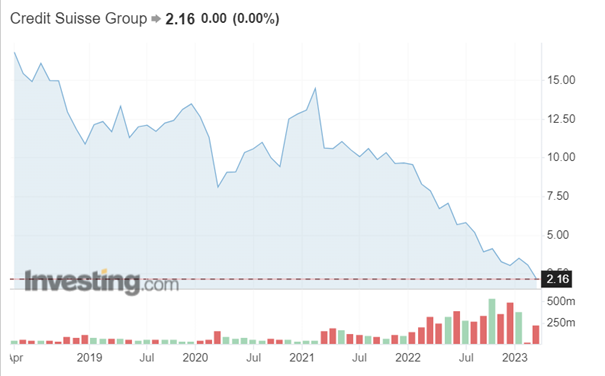But to easier understand, I had to start at the beginning – the break of SVB bank. First important article on Reuters reported, that SVB is in trouble and is right in front of collapse. Nevertheless, American government decided to help them and try to save them. But, despite that, the domino effect was in motion. First bigger hit took the American banks. But that did not stay there, as few days after that, Credit Suisse, the second biggest bank in Switzerland, reported problems and was facing a collapse if not offered help. I moved to the second article, where it was written that Central Bank of Switzerland offered a loan to Credit Suisse and that way calmed the European markets, which were all in red. Before the help came, stocks of Credit Suisse fell more than 30%.* In this same article it was said that Credit Suisse will borrow 50 billion euros, in effort to save themselves.
Moving on, but staying in Europe, I noticed another article on Investing, which said that ECB (European Central Bank) decided to raise the interest rates by 0,5 point. It’s a bold move if you ask me to do so right in the middle of big turmoil happening, however, it was also written that they decided to do this just because of positive news about helping Credit Suisse. Rate hike also signals strong confidence in European banks. However, I think they should still be careful, as many analysts said that the scenario looks very similar to the one in 2008, when great recession followed. But, about that we will see. I hope for the best.
I thought, ok, one more article and it was quite positive for the banks in Euro zone. ECB supervisors said that they don’t see any contagion to euro zone from bank turmoil, which is great. But maybe too soon to judge?
Moving on to technical analysis, I didn’t have much work there. The price of a stock was falling for the last five years. In 2019, the price of a stock was at around 17 euros, but it fell all the way to 2,16 euros.* However, I need to keep in mind, that Credit Suisse is too big and too important to collapse, so I predict that everyone will do as much as possible to keep it alive. That’s why I decided to buy stocks of Credit Suisse.

Movement of Credit Suisse stocks in the last five years. (Source: Investing)
* Past performance is no guarantee of future results.








